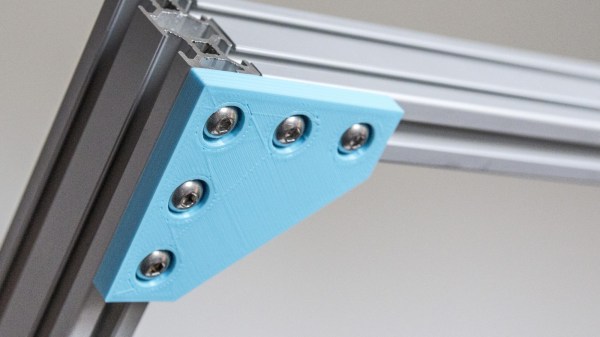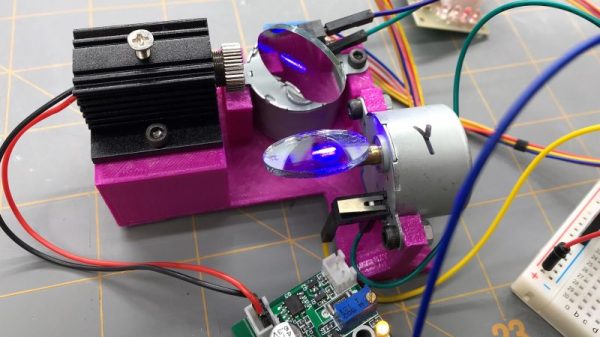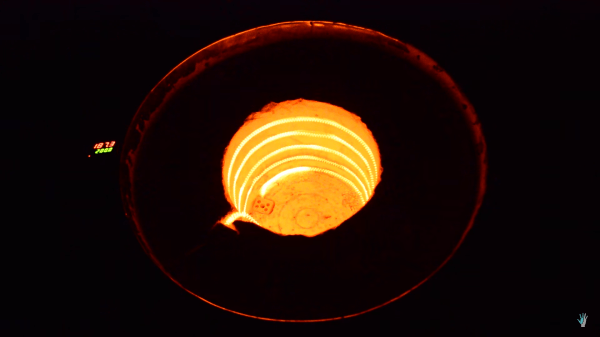Identifying ham radio signals used to be easy. Beeps were Morse code, voice was AM unless it sounded like Donald Duck in which case it was sideband. But there are dozens of modes in common use now including TV, digital data, digital voice, FM, and more coming on line every day. [Randaller] used CUDA to build a neural network that could interface with an RTL-SDR dongle and can classify the signals it hears. Since it is a neural network, it isn’t so much programmed to do it as it is trained. The proof of concept has training to distinguish FM, SECAM, and tetra. However, you can train it to recognize other modulation schemes if you want to invest the time into it.
Day: December 16, 2017
If 3D Printer, Then Custom Aluminum Extrusion Brackets
Aluminum extrusions are a boon for mechanical assemblies, but they require a stock of brackets and other hardware to be kept on hand. [mightynozzle] has decided to make things a little easier for prototyping and low-stress assemblies by creating a collection of 3D printable brackets for aluminum extrusions. 3D printing your own bracket hardware means faster prototyping, and if the assemblies don’t need the extra strength and rigidity of metal brackets you can just stick with the 3D printed versions.
The files are on Thingiverse, and include STL files of common brackets as well as an OpenSCAD script for customizing. Not familiar with OpenSCAD? No problem, we have a quick primer with examples.
This project showcases two things well. The first is that while brackets are not particularly expensive or hard to obtain, it can still be worth 3D printing them to reduce the overall amount of hardware one needs to keep on hand to make prototyping faster. The other is that 3D printing can shine when it comes to the creation of things like brackets: a few dimes’ worth of plastic can be turned into precise yet geometrically simple objects that would be a pain to make by other means. It certainly beats sitting on one’s hands waiting for parts to be delivered.
Poor Man’s Laser Scanner Probably Won’t Shoot Your Eye Out, Kid
Yes, laser cutters that come off the slow boat from China are more affordable than ever, and with some tweaks and hacks they can turn out some decent results. But if you just want a laser lightshow that’ll draw boxes on your living room ceiling, this simple X-Y laser scanner might be a good platform to build.
Let’s say right up front that there are more than a few safety issues with [ThingEngineer]’s 3D-printed two-axis scanner. He’s well aware of these potential retina-cooking issues and duly notes that a good pair of laser safety goggles is a must and that the cheap anti-lawsuit glasses that laser module manufacturers often include with their products don’t count.
[Editor’s Note: Glasses are really only intended for alignment operations. Pros enclose lasers beyond a certain power to prevent anyone going blind. Know where your beam terminates, kids.]
With that in mind, there’s a lot to be said for this poor man’s scanner build. Yes, it would be faster with real galvos and low-mass mirrors, but time is money, and the steppers and craft store mirror discs do the job, albeit slowly. We like that everything is so simple, even the method for turning a regular mirror into a front-surface mirror.
[ThingEngineer] proves you don’t need galvanometers to have some simple laser fun. And if steppers don’t do it for you, you can try little brushed DC hobby motors or even 3D-printed cams.
Continue reading “Poor Man’s Laser Scanner Probably Won’t Shoot Your Eye Out, Kid”
Hangprinter Build Videos
We figure with the rise in 3D printing, it is time for a new Finagle’s law: Any part you want to print won’t fit on your print bed. There was a time when a 100 mm x 100 mm bed was common for entry-level printers. These days, more printers have beds around (200 mm)2. A hangprinter’s work area can be larger. Much larger. [Thomas Sanladerer] is building one, and has a series of videos about the build. You can see the first one below, but there are several posted, including about 11 hours of recordings of live sessions of the build.
If you haven’t heard of a hangprinter, it is essentially a 3D print head that — well — hangs from cables and can turn an entire room into a 3D printer. When we looked at the original, it was printing a five-foot tall model of the tower of Babel.
Better 3D Printing Through Holography
When most of us think about 3D printing, we usually think about a machine that melts plastic filament and extrudes it through a nozzle. But we all know that there are other technologies out there that range from cutting and laminating paper, to printing with molten metal or glass. Many of those are out of range for the common hacker. Probably the second most common method uses photo resin and some light source to build the layers in the resin. Researchers at Lawrence Livermore National Laboratory (LLNL) and several universities are experimenting with a new technique that exposes photo resin using three lasers, printing an entire object at one time. You can see a cube formed using the technique in the video below.
In all fairness, the process really isn’t holography but LLNL refers to it as “hologram-like.” In fact, it appears the lasers project more like an oblique projection (you know, like in drafting) which is considerably simpler. Simple enough, that we can’t help but wonder if the hacker community couldn’t develop machines based on this principle. The key would be arranging for the resin to only cure where laser light overlaps.
Don’t Get Caught Up In Blockchain Hype
It’s the story of the moment, isn’t it. As the price of Bitcoin continues on its wild and crazy rollercoaster ride, everyone’s talking about cryptocurrencies, and in almost mystical terms, about blockchains. Perhaps to be a little more accurate, we should report that they are talking about The Blockchain, a single entity which it seems is now the answer to all ills.
Of course, there is no single blockchain, instead blockchain technologies form the underpinnings of the cryptocurrency boom. Since little dollar signs seem to be buzzing around in front of everyone talking about that subject, it has attracted the attention of hordes of people with little understanding of it. APNIC have a good article aimed at those people: Don’t Get Caught Up In Blockchain Hype, which is worth a read even if you do understand blockchain technologies.
It makes the point that many large enterprises are considering investments in blockchain technologies, and lists some of the potential pitfalls that they may encounter. There may be a slight element of schadenfreude for some of the technically literate in seeing this in action, but given that such things can have consequences for those among us it’s too important to ignore.
As an analogy of a relatively clueless executive jumping on a tech-driven bandwagon, a software company of our acquaintance had a boss who decided in the heady days before the dotcom crash that the organisation would fully embrace open-source. Something to be welcomed, you might think, but given that the software in question was a commercially sensitive asset upon which all company salaries depended, it was fortunate that he listened to his developers when they explained to him exactly what open source entails.
Whether you are a blockchain savant or an uninterested bystander, it’s worth a read as you may sometime need its arguments to save someone from their own folly. If you fancy a simple example to help understand something of how blockchains work, we’ve got that covered for you.
Bitcoin coins image: Mike Cauldwell [Public domain].
Digital Kiln
A kiln or foundry is too often seen as a piece of equipment which is only available if a hackspace is lucky enough to have one or individuals are dedicated enough to drop the cash for one of their own. [The Thought Emporium] thought that way until he sourced materials to make his own kiln which can also be seen after the break. It costs half the price of a commercial model not including a failed—and exploded—paint can version.
As described in the video, these furnaces are tools capable of more than just pottery and soft metal baubles. Sure, a clay chess set would be cool but what about carbon fiber, graphene, aerogel, and glass? Some pretty hot science happens at high temperatures.
We get a nice walk-through of each part of the furnace starting with the container, an eleven-gallon metal tub which should set the bar for the level of kiln being built. Some of the hardware arrangements could be tweaked for safety and we insist that any current-carrying screw is safely mounted inside an enclosure which can’t be opened without tools. There’s good advice about grounding the container if metal is used. The explanation of PID loops can be ignored.
What else can you do with a kiln? How about jewelry, heat treating metal, or recycle your beer cans into an engine.


















